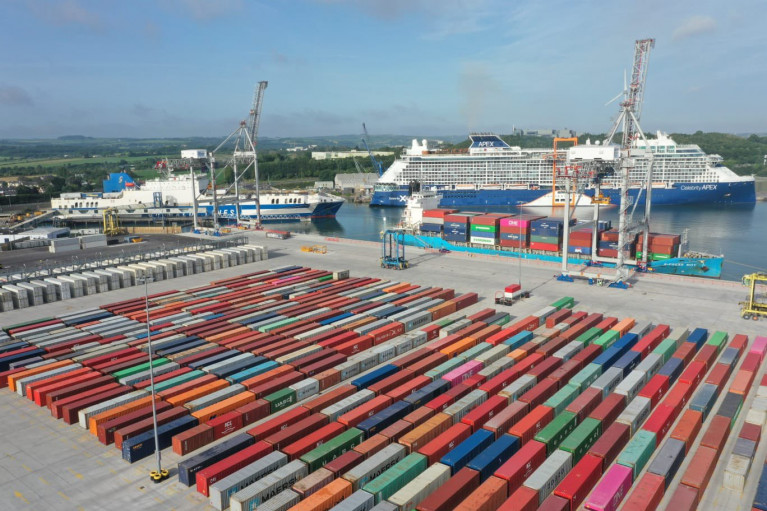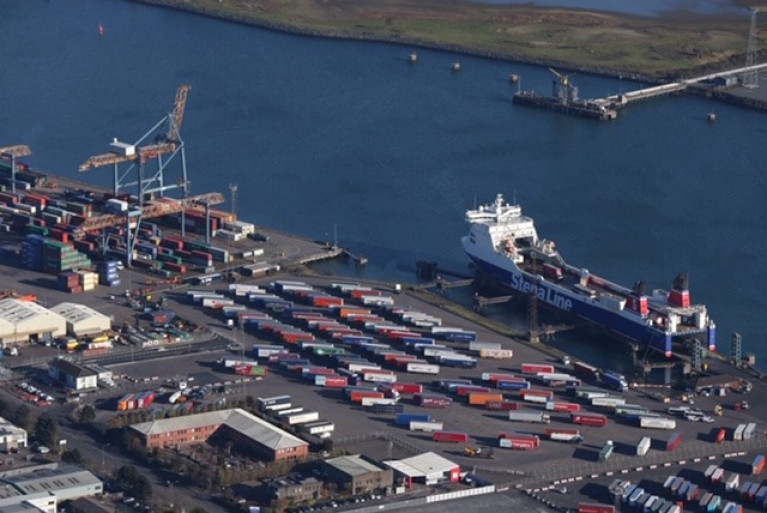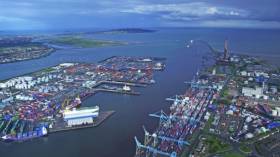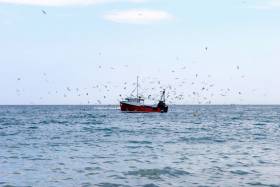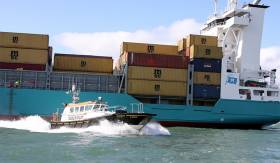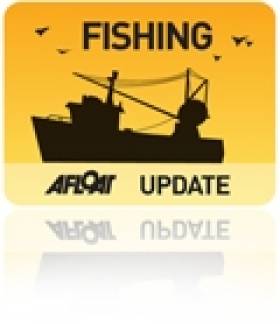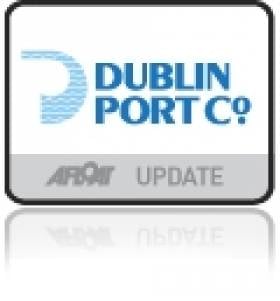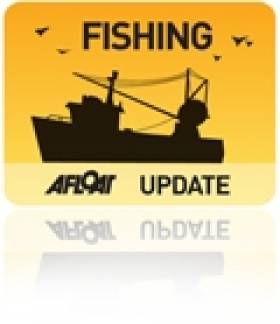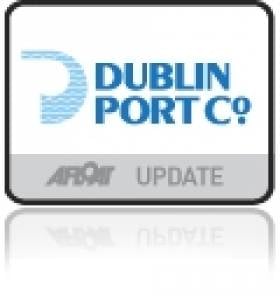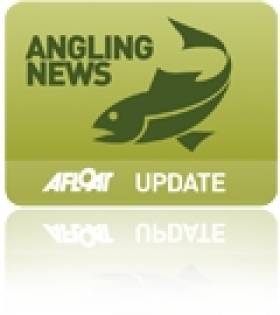Displaying items by tag: trade
The impact of Brexit across many sectors in the South West, in particular in agriculture, finance, and industry is revealed in a new report that shows Cork’s long history of trade with Europe has helped to cushion the worst effects of Brexit for the city and the wider region.
The report, ‘Cork and the Brexit Effect’, published by University College Cork, looked at Brexit’s consequences for the Cork region.
It was developed with local business, the tourism sector, higher education, and arts and culture stakeholders across Cork.
The report noted that relations and links between Cork, the North, and the UK have been affected by the fallout from Brexit.
It showed, however, that while visits to the Republic of Ireland from Britain and the North fell following Brexit, the Cork region was comparatively less affected by shifting tourist numbers than other parts of Ireland.
The report also suggests that Brexit has presented Cork with new opportunities and highlights how, since Brexit, the Port of Cork has seen its number of direct shipping routes to continental Europe increase as producers look to avoid the UK land-bridge.
EchoLive has more on the report that also examines aspects on the EU’s second-largest English-speaking city
The Minister for Foreign Affairs Simon Coveney has told Britain's Foreign Secretary that proposed legislation to change to Northern Ireland Protocol will create a whole new set of uncertainties and damage relationships.
The British government is due to publish details of proposed legislation to give ministers the power to override parts of the protocol.
The Irish Government and European Union have warned against unilateral action and urged a return to the negotiating table, but those pleas are set to be ignored.
Mr Coveney said it marks a particular low point in the UK’s approach to Brexit.
He spoke to Ms Truss by phone this morning, where she outlined her intention to publish the legislation today.
Mr Coveney said publishing legislation that would breach the UK's commitments under international law, the Brexit Withdrawal Agreement and Northern Ireland Protocol is deeply damaging to relationships on these islands and between the UK and EU.
For more RTE News reports.
New Dublin Port Customs Check Posts Will Be ‘Pinch Point’ Says CEO
New customs checkpoints in Dublin Port are expected to be a ‘pinch point’ for hauliers, according to the port company’s chief executive.
Eamonn O'Reilly tells RTÉ News that delays are likely to result from the new border inspection posts as Brexit would see a dramatic overnight increase in non-EU trade.
The new checkpoints are the first to be built in the port for decades, as their necessity waned in the 1990s thanks to free trade within the EU.
As previously reported on Afloat.ie, all sea freight requiring checks post-Brexit will be inspected at a 13,000m warehouse formerly owned by businessman Harry Crosbie.
UK Fishing Fleets Urged To Prepare For Catch Certificates In Event Of No-Deal Brexit
#Fishing - The UK’s fishing industry has been advised to prepare for the introduction of EU catch certificates in the event of a no-deal Brexit.
As Prime Minister Teresa May’s key Commons vote on her proposed Withdrawal Agreement looms tomorrow (Tuesday 15 January), fishing fleets around Great Britain and Northern Ireland have been reminded that in the event of a no-deal, most fish or fish products would require a catch certificate for trade with the EU from 29 March.
Catch certificates prove that fish has been caught in line with established conservation and management measures. All non-EU countries are required to present catch certificates when trading with the EU.
The UK Government says a new IT system to process and issue export catch certificates, and other supporting documentation, is being developed to help streamline the process.
Exporters would receive full instructions on how to register and use the new system before the UK leaves the EU. Import catch certificates would continue to be processed through the current paper-based system.
In addition to documents required under IUU regulations, businesses will also need to follow additional steps to comply with health and customs regulations in the event of a no-deal.
To plan ahead for creating a catch certificate, businesses and individuals that export fish products to the EU will need to know the species, vessel that caught it, date it was landed, and weight of the consignment.
Maritime Priorities In Transport’s Statement Of Strategy 2016-2019
#Maritime - ‘Safe and sustainable’ marine transport and ‘delivery of emergency management services’ have been made a high level goal in the Department of Transport, Tourism and Sport’s Statement of Strategy 2016-2019, published this week.
Identifying Ireland’s maritime sector as “a critical gateway” for trade and tourism, the statement calls for “an efficient and effective competitive ports sector [that] can foster job creation” via trade, infrastructure developments and “opportunities in other areas such as offshore energy, cruise and marine leisure and recreation.”
Reduced ship emissions and safety at sea are also priorities within the Maritime Safety Strategy, which “includes a range of actions to be implemented or begun by 2019” such as flag state and port state regimes, and the IMO’s Convention on Standards of Training, Certification and Watchkeeping for Seafarers.
Key services in this strategy include the delivery of a 24/7 marine emergency response and management service by co-ordinating the response to SAR incidents and pollution threats at sea.
Progress on these goals will be monitored by various indicators, such as the transfer of regional ports to local authority control by the end of 2018, the imposition of a new ‘ports performance’ measurement system by the end of 2017, the development of a web portal for SeaSafe Ireland by the middle of next year, as well as a minimum 90% availability of Irish Coast Guard units ahead of “full interoperability” of marine rescue co-ordination by next winter.
The full Statement of Strategy 2016-2019 can be downloaded HERE.
Irish Seafood Takes Pride Of Place At World Organic Trade Fair
#Seafood - Three seafood companies were among the eight organic food businesses exhibiting at this year's Biofach event in Germany.
Kush Seafarms in Co Kerry, Irish Seaspray in Co Galway and the Irish Organic Salmon Company in Co Donegal all return after last year's exhibiting at the World Organic Trade Fair in Nuremberg.
And they were joined at the opening of their stand by Minister of State Tom Hayes, who reiterated the opportunities that exists for the organic food market at home and abroad.
“Participation in Biofach allows our organic producers and processors to showcase Irish organic produce on a worldwide stage," he said. “It also provides ample opportunities to network with purchasing decision makers, both from Europe and further afield.”
Minister Hayes also paid tribute to Bord Bia “for the professional way that they have organised the Irish food industry’s participation at this very important event.”
He concluded: “I wish all participants here today every success over the coming days and I hope that you develop the partnerships and contacts that will help your business continue to grow into the future.”
Eight innovative Irish seafood and food companies are participating at the event, which runs till Saturday 14 February.
Last year, Biofach attracted over 2,000 exhibitors and in excess of 42,000 trade visitors attended the event.
Dublin Port Post 2014 As Record Year For Trade
#dublinport – Dublin Port Company today published trade statistics for 2014 which show a record year for trade at Dublin Port, with growth year-on-year of 7.0%. The stats follow a weekend interview with Dublin Port Company Chief Executive, Eamonn O'Reilly who mapped out the future for Ireland's major shipping port.
Total throughput for 2014 was 31 million gross tonnes with 7,108 ship arrivals in the year, bringing the port's activity back to the record levels of 2007.
Imports in 2014 were over 18 million gross tonnes, while exports exceeded 12 million gross tonnes, representing increases of 6.3% and 8.0% respectively on 2013 trade levels.
The recovery in the Port's trade has been export-led with volumes of exports 1.6 million gross tonnes greater than in 2007. On the import side there has been continuing recent growth (driven by improving domestic consumption) and this has pushed Dublin Port's overall volumes ahead to equal previous record levels of 31 million gross tonnes.
High levels of growth were recorded for trade vehicles, mostly new cars destined for dealerships around the country. The port received 81,169 trade vehicles in 2014, up 33.3% on the previous year. To accommodate the growing number of trade vehicles entering the port, Dublin Port opened a new €3.4 million 4.2 hectare trade car terminal at East Wall Road in October 2014. This new terminal can cater for 2,500 vehicles at a time.
There was particularly strong growth in the unitised modes with Ro-Ro trailers ahead by 7.9% and Dublin Port's Lo-Lo container businessahead by 9.4%. In 2014, the Ro-Ro sector achieved strong results with 821,876 units while Lo-Lo containers finished the year at 565,698 twenty foot equivalent units (TEU). The strong performance of the unitised business highlights Dublin Port as the island's port of choice for both Ro-Ro and Lo-Lo services.
SUMMARY OF TRADE STATISTICS
|
2014 |
2013 |
|
|
Throughput (‘000 gross tonnes) |
30,849 |
28,840 |
|
18,358 |
17,271 |
|
12,491 |
11,569 |
|
Ro-Ro (freight units) |
821,876 |
761,958 |
|
Lo-Lo (TEUs) |
565,698 |
516,872 |
|
Ferry Passengers |
1,710,275 |
1,607,987 |
|
Tourist Vehicles |
462,215 |
428,468 |
|
Trade Vehicles |
81,169 |
60,905 |
On the tourism side, 1.7 million ferry passengers travelled through the port in 2014, representing a 6.4% increase on last year and placing Dublin Port on a par with major airports including Cork and Shannon. In addition, 2014 was a strong year for the port's cruise business with 140,000 visitors on 86 cruise ships.
Eamonn O'Reilly, Chief Executive, Dublin Port Company, said: "2014 was an exceptional year for Dublin Port with a 7.0% increase in cargo volumes on top of the 3.0% we saw in 2013. The port is now back to the record levels of trade recorded in 2007 with every prospect of continued strong growth in the years ahead.
"During 2014, we saw strong increases right across our main business areas, from imports and exports to trade vehicle and ferry passenger numbers. We expect growth to continue into 2015, with importers and exporters choosing to do business through Dublin Port where they benefit from direct access and frequent services to their main markets.
"Dublin Port Company is committed to sustainable investment in port infrastructure and services including the longer, deeper berths envisaged in our Alexandra Basin Redevelopment Project. These will accommodate the larger ships of the future carrying increased cargo volumes and greater numbers of passengers. This type of investment will allow Dublin and the wider economy to prosper by ensuring that Dublin Port is ready to facilitate the future trading needs of its customers and the country as a whole.
"Having completed major investments during 2014 including the new €3.4 million trade car terminal and with the development of the Alexandra Quay Container Terminal nearing completion, we are looking forward during 2015 to commencing the Alexandra Basin Redevelopment Project which the EU is already supporting under its TEN-T infrastructure investment programme."
Minister Welcomes Outcome Of Ireland-Russia Talks On Meat, Dairy & Seafood Sectors
#Seafood - Marine Minister Simon Coveney welcomed the outcome of yesterday’s (18 December) high-level bilateral meeting in Moscow between his department and the Russian authorities on agri-food issues, including seafood.
The meeting was held at the request of the Department of Agriculture, Food and the Marine and built on the recent meeting in Dublin between the minister and the Ambassador of the Russian Federation to Ireland.
“Russia is an important market for Irish agri-food products but unfortunately this trade has been restricted by issues arising from the Russian ban on EU food and drink products as well as their audit of Ireland’s exporting plants earlier this year," said Minister Coveney.
"Through the Irish Embassy in Moscow we have been actively pursuing a bilateral meeting for some time to complement the intense engagement which we have had with Russian counterparts over the last few months. I am pleased to hear that yesterday’s meeting continued the constructive dialogue between both sides and progressed a number of key issues.”
The meeting focused on the department's response to the interim report on the audit findings received from the Russian authorities earlier this year.
The comprehensive response, incorporating the corrective actions for each establishment visited, has been submitted in full and the Russian side confirmed at the meeting that the final report will issue before the end of this month.
Commenting on this, the minister said that “confirmation that the final report will arrive before the end of the month was very welcome and gives us a solid basis for resolving these issues.
"We will prioritise our response to the final report with a view to having the temporary restrictions lifted on the affected dairy, beef and seafood plants as soon as possible.”
The meeting concluded with a proposal by both sides to meet again in January.
“I am under no illusion that considerable work remains to be done if we are to regain some of the market share prior to the events of this year," added Minister Coveney. "Equally it must be remembered that some of this market restriction is common to all EU Member States and stems from political issues unrelated to the agri-food sector.
"Nonetheless I am encouraged by the positive spirit in which this bilateral discussions took place and most importantly that there is a clear roadmap for future engagement and that another meeting is confirmed for January.
"In parallel to these discussions, I will be continuing my engagement with the European Commission and my counterparts from other EU states to ensure that the right market support measures are being deployed to help producers and processors in Ireland to help overcome the effects of the Russia ban."
Ireland’s agri-food trade to Russia in 2013 was worth €235m before EU sanctions were put in place.
Dublin Port Ferry Passenger Numbers fell by 5.6% to 1.7m
#PORTS – Dublin Port Company today published trade statistics for 2011. Total throughput in 2011 was broadly in line with 2010, down by only 0.1% to 28.1m tonnes. Within this, however, exports continued to grow and were up 2.8% in the year at 11.5m tonnes.
2011 trade statistics summary:
Total throughput – 28.1m tonnes, down 0.1%
Exports – 11.5m tonnes up 2.8%
Imports – 16.6m tonnes down 2.0%
Bulk Liquid – 3.6m tonnes, down 4.7%
Bulk Solid – 1.6m tonnes, up 10.8%
Unitised trade now accounts for 81% of Dublin Port's business. During 2011, Ro-Ro freight volumes were virtually unchanged at 725,000 units. In contrast, Lo-Lo volumes fell by 5.1% to 526,000 TEU.
Ferry passenger numbers fell by 5.6% to 1.7m. This follows a record year in 2010 when numbers were boosted by the impact of weather and ash clouds. Compared to 2009, passenger numbers were up 11.1%.
With 1.7m ferry passengers moving through the port, Dublin Port is behind only Dublin Airport and Cork Airport as a national tourism gateway.
The cruise liner side of Dublin Port's business saw a 7.5% increase in cruise passengers. During 2011, 87 cruise ships brought over 135,000 passengers and crew to Dublin.
Commenting on the trade figures, Eamonn O'Reilly, Dublin Port Company's Chief Executive said:
"Trade levels at Dublin Port were steady in 2011 which is a robust performance given the large (6.1%) increase in the port's volumes in the previous year.
"Whereas export volumes have continued to grow and are now 0.5m tonnes higher than they were in 2007, the poor performance of the domestic economy has resulted in a continued decline in imports. These are now 3.4m tonnes lower than they were in 2007.
"Notwithstanding the poor performance of the economy we are continuing to plan for the future and will shortly be launching our Masterplan 2012 to 2040. Dublin remains the largest and most important port on the island and our Masterplan is intended to ensure we continue to provide vital port capacity particularly as the economy returns to growth in coming years.
"With all the difficulties in the economy we are still only 9% behind where we were at the peak in 2007 and we believe that any pick-up in domestic demand will quickly translate into growth in import volumes. The Masterplan will ensure we stay ahead of future growth in demand for decades to come".
Second Irish Fly Fair Set To Be Bigger and Better
#ANGLING - The Irish Fly Fair and Angling Show at the Galway Bay Hotel next weekend be "the biggest of its kind in Ireland", hosting the largest number of fly tyers and trade stands from over 15 countries, according to organisers.
The two-day exhibition, now in its second year, will welcome some of the world's top fly tyers and angling celebrities to Salthill.
As with the first event last November, visitors will have the opportunity to learn from the world's best fly dressers and casters, with tuition provided by APGAI Ireland.
Returning angling celebs Hywel Morgan, Glenda Powell, Stevie Munn, Paddy McDonnell, Peter O’Reilly will be joined by newcomer Scott MacKenzie to advise on all aspects of fly fishing.
Among the new events this year is the youth fly tying competition, giving younger anglers a chance to show the pros what they can do.
Experts from Inland Fisheries Ireland, the Wild Trout Trust and many more will also be hosting talks and seminar on various angling-related topics.
And all that is aside from the huge trade aspect of the weekend.
"Building on the success of last year’s show, where business was brisk, the 2011 show has attracted trade from all over Europe who are keen to come to Galway and exhibit to the Irish market," said organiser Grace McDermott.
For more details on the second annual Irish Fly Fair and Angling Show visit www.irishflyfair.com.



























